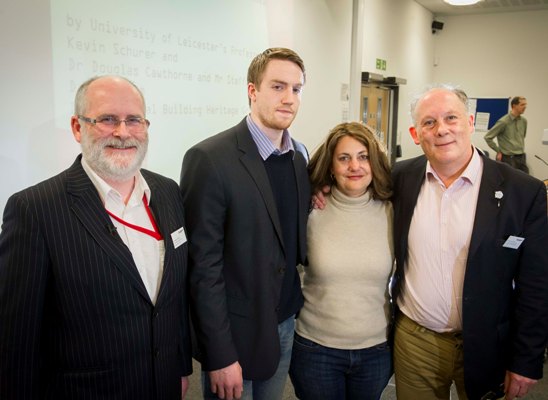Richard III relative praises DMU research
One of the two last remaining relatives of Richard III whose DNA helped prove the remains found under a car park were those of the last Plantagenet king, has praised De Montfort University Leicester (DMU) researchers for their work in digitally reconstructing the friary where his remains were found.

Australian Wendy Duldig, who is in Leicester for the week to commemorate Richard’s interment, said the digital fly-through of Grey Friars, created by DMU’s Digital Building Heritage team was one of the best exhibits in the Richard III Visitor Centre, which has been packed with tens of thousands of tourists in the last few weeks.
Ms Duldig, who has made headlines around the world as one of the last two remaining descendants of Richard III, through his eldest sister Anne of York, attended a lecture at DMU last night where Dr Douglas Cawthorne, principal lecturer within the School of Architecture and leader of DMU’s Digital Building Heritage team|, and PhD researcher Steffan Davies, explained how the building was recreated.
Ms Duldig said: “It is one of the best things in the exhibition (at the Richard III Visitor Centre). It makes the discovery of Richard III very real for people.”
Ms Duldig said her week in Leicester had been “extraordinary” and she was attending the lecture as she “wanted to learn everything about Richard”.
The event, in DMU’s Hugh Aston building, also had a presentation by University of Leicester’s Professor Kevin Schurer, who explained the incredibly detailed research he and his team undertook to prove the remains were Richard III.
One of the genealogist’s slides showed the genetic map of Richard III compared to that of Wendy Duldig and the other remaining relative, Canadian Michael Ibsen, were an exact match, despite a gap of 500 years.
He explained that taking into account the location of the bones, the age of the bones, the battle wounds, the carbon dating and the DNA matches, the probability of the remains being Richard III were 99.9999%. In other words, the chances of the bones not being Richard III’s was one in a million.
RELATED NEWS
How DMU research recreated the Church of the Annunciation
Come to the DMU Heritage Centre to see our connections with Richard III
Visit DMU and see how we help you to learn to succeed
Mr Schurer also revealed Richard left no direct descendants but “we are all related to Richard. The question is most of us don’t know how to make the link”. He added: “Richard will have between one million and 17 million close relatives of his extended family around today”.
Following the lecture, visitors to DMU were taken to the university’s new Heritage Centre, where the last remaining arches of the Church of the Annunciation stand. The Church of the Annunciation is where it is believed the battle-scarred remains of Richard III were put on public display following the Battle of Bosworth to prove to the people of Leicester that he was dead.
Bob and Elaine Duncanson have travelled from Kitchener, Ontario, in Canada, to be in Leicester for the interment.
Bob said: “We are very much appreciative to DMU for putting this on. It is amazing what you can do now to digitally recreate something.”
DMU’s acclaimed Digital Building Heritage Group| created the CGI animation of Grey Friars Church, to be shown on a big screen at the Richard III Visitor Centre exhibition called Dynasty, Death and Discovery.
It includes the now-lost original tomb of Richard III, which marked the grave before the friary was razed to the ground in 1538 and the area sold off to property developers.
The team has also digitally recreated the Church of the Annunciation for the first time, which can be seen in the DMU Heritage Centre alongside the arches.
The team is renowned for its work to record, visualize and interpret historic buildings and artefacts. It has worked with a range of organisations on projects around the country and their research has been recognised as being of international importance.
The DMU Heritage Centre, which is free to visit, is open every day this week from 9am to 5pm. The DMU team is also running tours of DMU’s medieval campus, including the centre, Trinity House and the Chantry. The tours take place tomorrow and Friday every hour between 11am and 2pm. There is no need to book in advance to attend a tour and they are free of charge.
Posted on: Wednesday 25 March 2015